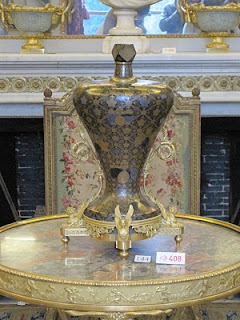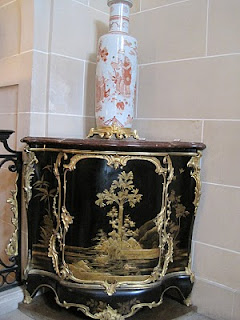Located on the edge of the Parc Monceau in Paris lies one of the cities most extraordinary museums. The Hotel Camondo was designed by the French architect, Rene Sergent (1865-1927) and completed in 1912 for the wealthy banker Moise de Camondo. In 1860 Comte Moise was born into a Sephardic Jewish family in Istanbul, Turkey. His family owned one of the largest banks in the Ottoman Empire. As a child the family moved to Paris to establish their astonishingly successful bank and Comte Moise continued in his father, Nissim de Camondo's footsteps by running the business.
In 1891 Moise married Irene Cahen d' Anvers and they had two children. Nissim (1892-1917), who was named after his grandfather, and Beatrice (1894-1944). Moise and Irene were divorced in 1902.
The Hotel Camondo was inspired by the Petit Trianon at Versailles and built to house Moise's astonishing collection of 18th century French furnishings. The collection included a French silver service ordered by the Russian royal Catherine II, Buffon porcelain from Sevres, Savonnerie carpets, and furniture by Jean Francois Oeben, Jean Henri Reisener, and Georges Jacob.
Despite the influence of the Petit Trianon, the interiors were designed to be beautiful yet functional and quite modern for their time. Typically period rooms were arranged enfilade but the interiors of the Hotel Camondo were designed without this typical feature, making the rooms much more livable and private.

Looking up at the mansions exquisite architectural details. I love the curves of the projecting wings.

The Salle a Manger or dining room featuring the Catherine II silver service and the Sevres porcelain.

An amazing bronze bust. Note the gilt bronze earrings!

A detail of the boiserie in the dining room.

The drawing room includes a marble bust by Jean Antoine Houdon and a 17th century Japanese sake bottle with 18th century gilt bronze mounts. This piece was owned by Madame de Pompadour. Note the original 18th century needlepoint upholstery on the settee and the firescreen.



A close up of the Japanese sake bottle. Note the shaped stopper and the exceptional gilt bronze mounts.



The private study of Comte Moise de Camondo. Before she was married it was the bedroom of Moise' daughter Beatrice.

Look closely at how beautiful the pictures are hung. I will have to remember this for a future project!

 Such a handsome room!
Such a handsome room!
Nissims bedroom and study. My favorite room in the house. The portrait over the daybed is of Nissim's father, Moise de Camondo.
 The back stairs that were privately used by the family.
The back stairs that were privately used by the family.Tragically in 1917 Nissim, a volunteer fighter pilot during World War 1, was killed during a mission. Comte Moise was devastated to lose his son. He had built the Hotel Camondo for Nissim who shared his fathers same passion for the decorative arts. Sadly Beatrice did not share her fathers passion and had no interest in continuing the legacy of the house.
Upon Comte Moise' death in 1935 he bequeathed the state of France with the house and it's entire collection in honor and remembrance of his son. The museum was officially opened in 1936 and has been perfectly preserved ever since.
But the tragic fate of the Camondo family continued. During World War II, Beatrice, her husband Leon Reinach, and their two children were sent to German concentration camps and exterminated in 1944. One cannot help but feel thankful that Moise did not live to witness the horror of the Second World War and the unspeakable loss of his remaining family. The Camondo family name died with Beatrice and her children.
To walk through the rooms of the Musee Nissim de Camondo is to feel as if time has stood still. The museum has preserved the house and it's furnishings exactly as it had been during the family's residence.
After losing Nissim, Moise withdrew from social life and focused his attentions on his collection and to share it with a small group of friends who shared his passions for gourmet food and the decorative arts.
Despite the immense beauty of the mansion, there is an underlying sense of sadness that still permeates the house. One can especially feel it in Nissims bedroom and Moise's private study where he would often shut himself off from the rest of the world.
Regardless it was a truly amazing experience and offers one a glimpse of an extraordinary man's life and his testament to the best of the French architecture and the decorative arts.
All photos taken by Michael Hampton



















14 comments:
What an achingly beautiful place - the arch in front of the mirror, with the rosette detail, is exquisite.
I just read about a house in DC - on Architect Design - that the owners offered to sell to the Smithsonian, with all of its amazing collection of furniture. The SMithsonian had no endowment at the time (early 20th century), and could not buy the home. Too bad the owners did not give it to the Smithsonian - I am struck with the generosity of this family, which makes their fate even sadder.
My favorite museum - visiting is more like seeing a private home than a museum, the home of a collecting family that shows how they lived with the things they loved. And it is done so beautifully - the dining room is my idea of a dream lunch location. Thanks for sharing this gem with many who may not even have heard of it - it's on my "don't miss" list for Paris!
I've so wanted to visit this museum for a long time, but didn't have the chance while in paris this past fall. Hopefully this year will be the one! Have you seen the book (in english) about the house -it's perfection - "the camondo legacy" - a must for any library!
You captured this house perfectly. I too felt a great sadness there when I visited it more than a decade ago. Wonderful post.
Just beautiful! Thank you so much for this.
And, by the way...you should pick up a camera more often!
Just discovered your blog vis Twitter. How enjoyable! I have not been able to travel for about 5 years now. Thanks for taking this ex-flight attendant down memory lane. You have a new fan.
This is one of my favorite museum in paris , another one is Jacquemart Andre
I taught a sketching/history class conducted entirely in the field at Parsons Paris one summer and was very impressed with both this magnificent house and its outstanding collection of furniture. I own the museum guidebook that gives a history of the house but primarily showcases the furniture. Does anyone know of a book that features the architecture of this wonderful house?
My favorite place in Paris, i am going the weekend of valentine :-)
David
I would love to say I've had salted caramel coffee, but alas I have not. Looking forward to the day I do. Beautiful blog.
Wonderful story about the house and the family. I just visited it last week, and was wondering how was it that the house and furnishing survived WWII and the Nazi occupation?
Hello, :-)
Well the collection and the house survived because in the 20-30 it was already a french museum and that way the germans couldn't take it it their possession. The family ended not so good.
David
This is one of the few museums in Paris I have not visited. Your photo's are beautiful! Thanks for taking me to the 18th century!
Thank you Michael for sharing this amazing and beautiful Musee Nissim de Camondo. We have just returned from two weeks in Paris but unfortunately, it was not open on the day that we finally made it to the 8th. But the nearby Jaquemart-Andre was open and we were able to enjoy it as well partake of the Edwardian ambiance of the Parc Monceau. I urge everybody to get away from the crowds and enjoy this part of Paris.
Post a Comment